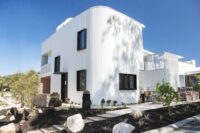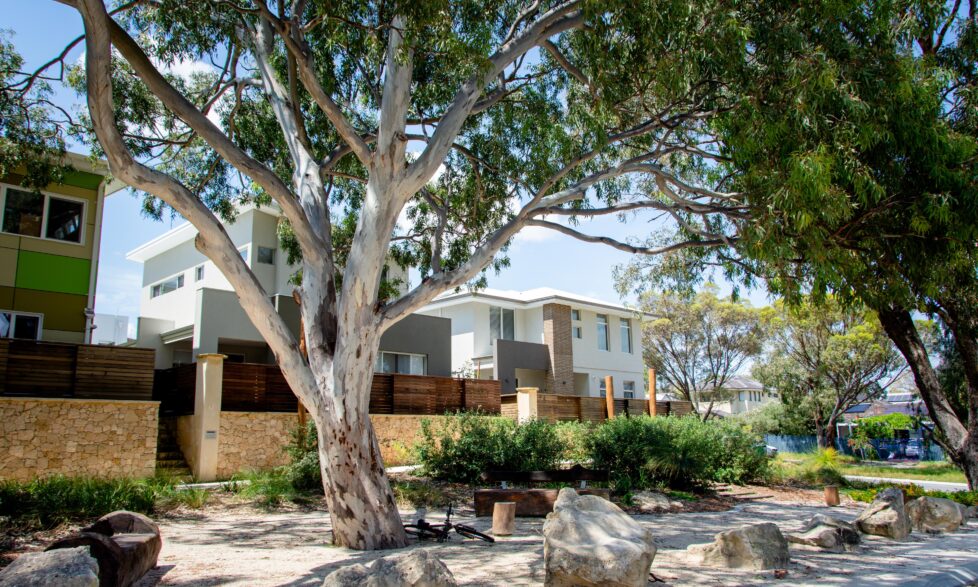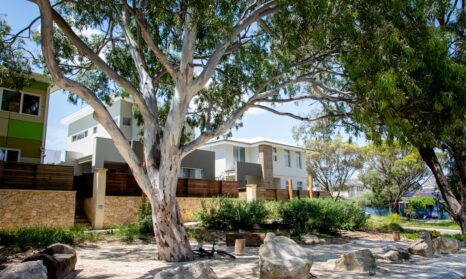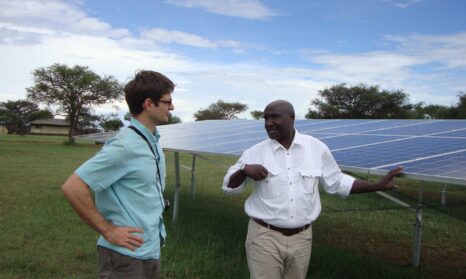In conversation with Greg and Warren – two of the driving forces behind WGV
WGV at White Gum Valley in Western Australia is a DevelopmentWA demonstration project of more than 80 homes close to the centre of Fremantle, a One Planet City.
It includes single lots for self-build detached dwellings, maisonettes and apartment buildings. There are also several demonstration housing projects aimed at providing affordable housing to people in their 20s and 30s, and an artist’s cooperative.
As all the buildings were delivered by private developers and individuals, WGV required a highly innovative approach to ensure sustainability standards are met, involving creating a structure plan or masterplan that enabled sustainability, setting detailed design standards for developers and home-builders, and supporting this with a sustainable up-grade package and the provision of centralised construction site services.
From the outset, the project set itself very high standards, with the majority met and even exceeded. But what is so impressive is that this has been achieved while creating a very diverse community, a wide range of partners, and high levels of innovation.
As the project nears completion, I asked Warren Philips the project manager and Greg Ryan the sustainability manager about their experiences.
What do you think has been the biggest success of WGV?
Greg: Well apart from simply being the first major One Planet Living project in Australia, it has been really pleasing to see how the strong sense of community has developed. Residents have started initiatives in sharing tools and other equipment, creating Facebook groups and SHAC (Sustainable Housing for Artists Cooperative) runs many events a year. I think this has helped a lot during Covid, with residents offering help to each other and benefitting from the green space at WGV.
Warren: - and don’t forget the site generates more energy than it uses!
What have been the biggest challenges?
Warren: The level of ambition at WGV grew throughout the project. We wanted to make the final plot a ‘Baugruppen’ (akin to a housing cooperative), but this has had to be scaled back with a smaller Baugruppen and some single lots. The electric car sharing scheme also didn’t manage to take off commercially, though interestingly members of the community stepped in and bought the electric vehicle and are sharing more informally.
WGV is a pretty small project - has it had much of an impact outside the organisations directly involved?
Warren: The project has drawn national as well as local recognition and highlighted how net zero carbon can be achieved. We also have seen other developers replicate the approach on other sites.
Patrick: The City of Fremantle has its own commitment to One Planet Living dating back to 2015. It has recently created a very innovative new planning regulation called The Freo Alternative, which allows higher-density development if high sustainability standards are met. This is essentially the model that WGV pioneered.
What are your top takeaway messages from the WGV project?
Greg: The sustainability guidelines and minimum standards set for all construction onsite were essential for setting the baseline that all housing had to meet.
Warren: I agree, though it was difficult to get the mainstream housebuilders to work within the guidelines. It was much more successful when the owners used a builder who was already familiar with sustainability. The subsidised sustainability upgrade package offered to the purchases was widely taken up, which assisted with the installation of rooftop solar PV arrays and rainwater harvesting tanks plumbed into the houses.
Greg: The communal facilities at WGV are excellent and the BBQ area, pocket park and Sullivan Hall are all well used as recreational and meeting places. A large area of land next to the Hall remains available for expanding the public open space and is awaiting the community and City of Fremantle to finalise their plans. Also I think while the information pack we provided was useful, if we had taken more time to follow up with residents after they had settled in, and they had a little more time to think, it would have helped reinforce some of the sustainable lifestyle messages and opportunities.
Patrick: So to summarise: Clear minimum standards, incentives to go further and high-quality community space to encourage neighbourliness?
Warren: Yes, this final point might help encourage a wider move to more compact housing, leaving more green space and gardens, if residents understand that they have access to a range of high-quality communal facilities.
Finally, who have been the hidden heroes of WGV?
Greg: Through our partnership with Curtin University we’ve had some wonderful researchers helping out. Dr Jess Breadsell has been fantastic in helping us learn about what is and isn’t working for the community. There are some specific residents who have made a huge contribution too - such as setting up the Facebook group in WGV’s early days, organising meetups and championing waste reduction initiatives. Generally, I think the approach taken at WGV has helped unlock many people’s desire to be creative and have a positive impact.
Patrick: Thanks both for those fantastic insights and we look forward to seeing you implement more One Planet Living projects!








